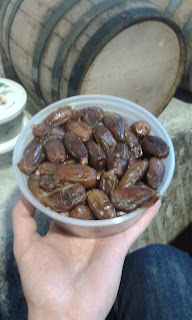I have checked in on the pellicle again as I am interested to see it during different stages of development. Here is a picture of its current state.
As compared to the picture in my previous post, it appears as if little colonies have developed. The aroma coming from the barrel is increasingly funky.
You may remember that in addition to the 225 liter barrel, I had enough wort left to fill a small 5 gallon barrel. To ferment the 5 gallon barrel, I used an assortment of commercial sour dregs collected at a beer tasting event. It is interesting to compare the pellicle formed in the big barrel (above) to that of this 5 gallon barrel (below).
There are a few major factors that cause such a different pellicle formation between the two barrels. The primary factor would be the different yeast source. Another factor is the 5 gallon barrel has higher oxidation due to greater surface area with the oak. In addition, there was only about 4 gallons remaining to fill the 5 gallon barrel, so it is a relatively short fill resulting in a larger head space. This head space has theoretically been filled with CO2 during the primary fermentation phase, however I do not doubt a certain amount of oxygen was present as well.
I don't want that much head space in the 5 gallon barrel during the aging process. After some consideration on what to do, my plan for this 5 gallon barrel is to make the Sikaru I talked about earlier. To do this, I will be adding dates and honey to the lambic. The rule of thumb in fruiting lambic is 2lbs of fruit per gallon of lambic, so I will be requiring 8-10 pounds of dates. Normally fruiting is done a few months prior to bottling, however, I will be adding a portion of the dates now to eliminate the unwanted head space in the barrel.
I purchased 4.5 pounds of whole dates. I'm not 100% sure the reason behind using whole fruits, however I know Cantillon and others insist on it, and so I made sure to follow suit.
I wanted to wait until primary fermentation had ended to add the fruit, but make sure they were added before the aging stage started. With the amount of sugar in dates, and the amount of dates I added, I wouldn't doubt if I saw a reasonably strong second fermentation. I'm not worried that I've damaged the existing pellicle (and of a second fermentation damaging it further). It was not dense enough to fall, and the disturbed area will grow back in short time.






1 comment:
Could you elaborate on the type of wood used in the barrel construction and ambient temps? Cheers, great stuff.
Post a Comment